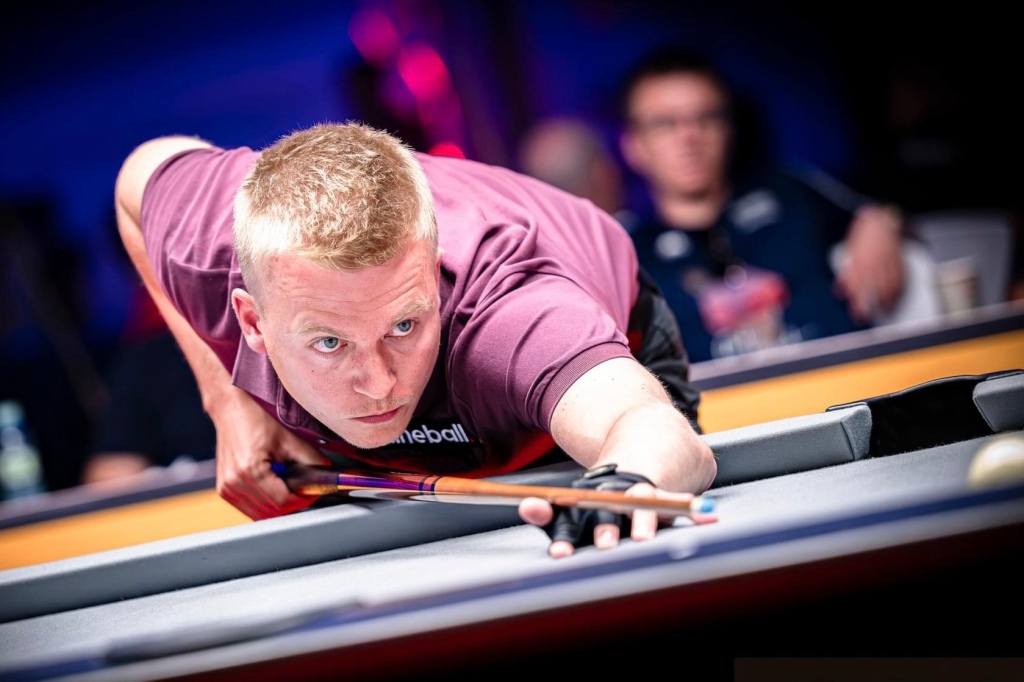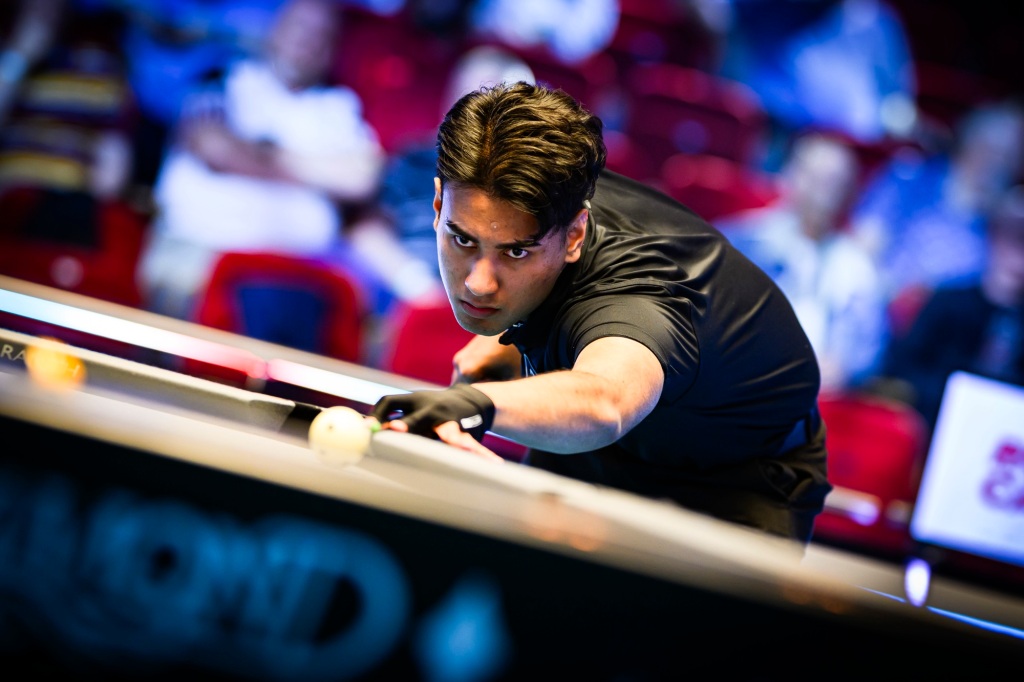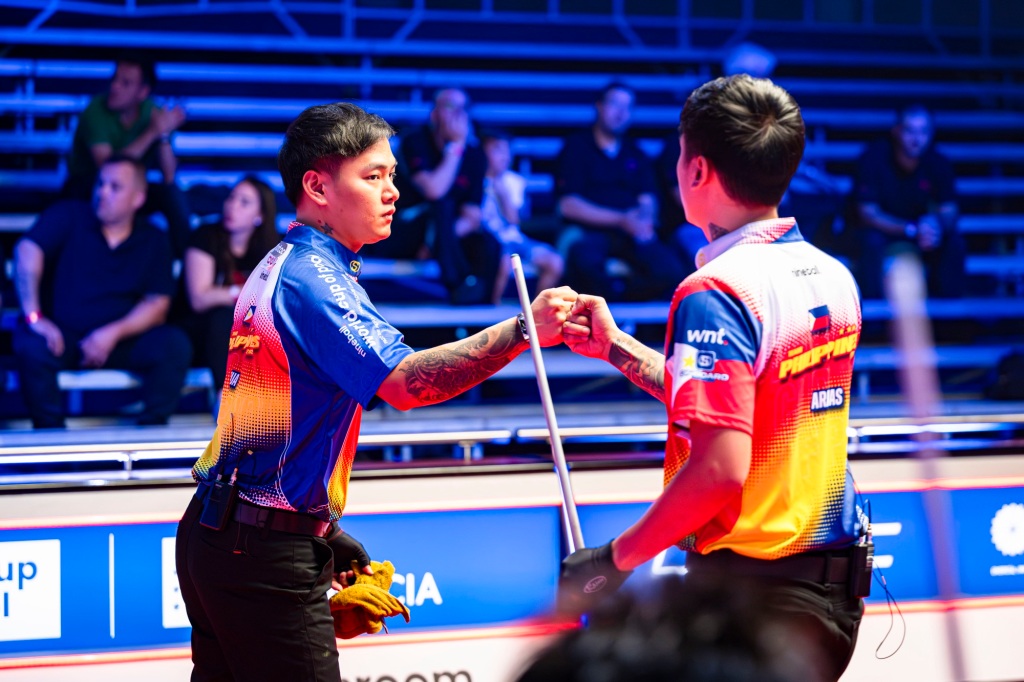“For me to now be in a position where I know I can compete with the calibre of these players, sometimes I have to really pinch myself as I never set out to achieve these heights,” says Britain’s Tom Staveley, casting his mind back to watching the world’s elite competing in the World Pool Championship and the Mosconi Cup on TV during his childhood.
Staveley was well aware of nine-ball pool despite it not being all too detectable in a country where snooker and English eight-ball are the predominant disciplines. However, it wasn’t until relocating two hours north from his seaside hometown of Brighton to London for university studies that he would engage in the game from a playing perspective.
“I grew up playing snooker on my grandad’s table from around the age of twelve,” Staveley adds. “I was there every other weekend and would go missing for hours, playing non-stop. I was completely addicted to the game and still, to this day, I think it’s my favourite discipline of cue sports.
“When I moved to London for university in 2007, there were no decent snooker tables around in the East End at the time. Instead, I started to pick up a bit of American pool with some friends at a club in Mile End.
“After approximately three months of playing, I eventually won the weekly nine-ball comp with a house cue and immediately decided to reinvest the winnings that same day, purchasing a secondhand cue from the club’s night manager. I haven’t left the game since.”
Pool was a mere hobby and a welcome distraction to studying for Staveley but his maiden amateur success arrived in a timely manner regardless. In spite of that, his debut appearance in a major tournament came a decade down the line – when Matchroom purchased the rights to stage the prestigious US Open Pool Championship.
“It was quite late really. It wasn’t until 2019 when I decided to enter the US Open,” reveals Staveley. “At this point, I had around twelve years of competition behind me, having progressed from playing in local amateur tournaments and the main UK tour, to various events around Europe. This was the first trip where I had the opportunity to compete in the US – the game’s motherland.
“I had a US national in the first round, who was a regional qualifier. I didn’t play too badly and got the win. I had the defending champion Jayson Shaw in the second round though, who had just come off the TV table with a blistering performance, whitewashing his opponent.
“Since he was the man of the moment back then, I knew I had it tough and there was a sizable crowd building around our table ready as soon as we lagged off. I felt nervous going in because of the unfamiliar setting, so was a little shaky from the start.
“I grew more comfortable after the first couple of racks though, so managed to keep the score somewhat respectable, losing out 11-5 in the end. In losers round two, I had a lengthy battle against a Canadian player that went the distance, only to lose painfully to a fluked ball in the deciding rack. A tough loss indeed.
“On reflection though, it was an incredible experience to say the least. Playing on premium equipment under the promotion of Matchroom, I really felt like a player and it made me hungry for more.”

Having dipped his toes into the merciless environment that would eventually evolve into what today is known as the World Nineball Tour, Staveley, currently the British number eight on the world nineball rankings, has improved upon his fundamentals and since laid the foundations of a promising career.
Incidentally, last year’s UK Open Pool Championship, held at London’s Copper Box Arena, only a short trip on the tube from his home, was where Staveley caught attention. He battled through back-to-back hill-hill affairs to qualify for the single elimination phase of an open championship for the first time, only beaten by eventual quarter-finalist Mieszko Fortunski in a deciding rack.
But what sparked that run in London? Being at ease and reassured was his honest answer. “I think the number one aspect for me was just simply feeling comfortable at the table, which allowed me to bring out my top game more often,” Staveley expresses.
“I’m not sure how I managed to get to that point but if I had to guess, it was probably from simply playing in lots of the bigger tournaments more frequently. That led to me to knowing the top players on the circuit on a more personal level.
“On a few occasions last year, I competed in international tournaments back-to-back, travelling with these pro players on the road or at the airport from one event to the next. You really get to sense that you’re a part of the full-time circuit and helps to eliminate the imposter syndrome that has held me back from time to time.
“On a more technical level, addressing changes to my eyesight through realignment of the cue and the body position was certainly needed. Understanding this has been crucial and really opened my eyes to how I had always played with a degree of compensation in my cue action, which I feel limited what I could achieve.
“I was keen to address other parts of my cue delivery and now find myself working with Elliott Sanderson, who was able to instantly recognise and correct so many aspects. This is without doubt the most drastic, technical change I will ever make to my game but no doubt one that was needed, so I look forward to reaping the rewards during the years ahead.”
Those tweaks to his fundamentals in an amendment designed to develop consistency required a period of adjustment and there were hurdles to overcome, including relative disappointments in Germany and Spain, where he accumulated a mere two victories in total.
Nonetheless, Staveley embarked on an ultimately confidence-boosting American trip, competing in two warm-up events ahead of the prestigious US Open. An extraordinary scalp was perhaps the highlight of his journey stateside when beating two-time world champion Thorsten Hohmann at the Connecticut Open, held at Jayson Shaw’s room in West Haven.
“2023 was a big year in pool for me in general, not just because of some wins against decent players,” Staveley says. “Going into the year, I had committed to playing as many ranking events as possible to make an active push towards securing a spot inside the top 128 of the WNT rankings – a goal of mine come the end of the year.
“Technically however, I felt the worse I had done for a long time due to making several fundamental changes to my technique in an effort to improve my all-round game. In the end to get relatively close to that goal without having my game in top shape I think shows how I’ve changed my approach to match play, still being able to grind out some wins when not feeling 100 percent.
“It wasn’t until the trip to the States that a few things started to click into place, and just in time too with three big events en route, all stacked with a monster field of players. The Connecticut Open was without doubt the highest standard competition I’ve ever been involved in – 64 of the world’s best players competed a few days prior to the prestigious US Open.
“I had a monster draw ahead of me but knew that anyone can beat anyone in this game, so I just decided to really focus on myself and the balls in front of me. We both played a strong set and after getting to the hill first at 8-7, I had the break and hit a golden. It’s a tough way to lose for Thorsten but obviously I was delighted to see the nine drop in the side.”
Reflecting on his first actual flurry of tournaments stateside, Staveley adds: “It was expensive but truly valuable to me. After my win against Thorsten, I managed to capture a 9-6 win with another strong performance against [Spanish Open runner-up] Marc Bijsterbosch in the second round of the US Open.
“It felt great to have another big scalp under my belt of course. It was the first pattern I identified in my game. After two strong wins, I lost heavily in the following rounds. Despite not having much table time, I knew I had to really value being at the table more, even if involved in a safety battle or kicking at a ball.

“Those at the top of the game know this all too well and are still able to get the wins if down in a match by getting control of the table back, especially in the winner breaks format.
“I met a lot of fresh faces, learnt a ton about my game and managed to reinstall some much needed belief. It enabled me to identify specific areas of my game that I needed to improve and more importantly how to go about correcting them.”
Staveley is one of the few British players that are fortunate enough to frequently pit themselves against the world’s elite. Investing in their game is something that is quintessential for players when attempting to compete internationally because extortionate travel funds often exceed tournament earnings.
“It doesn’t make financial sense [for Brits to compete abroad], which of course applies to most other countries too,” Staveley candidly assesses. “Those who like to compete occasionally and treat it as a holiday is one thing but for the stronger players who are hoping to make a career out of nineball pool, it’s very tough to do so unless you’re able to consistently rank within the top 16 on the WNT rankings.
“After expenses, to be self-sufficient and earn a living playing the game, it’s an incredibly tough achievement with the current prize funds available. Of course it’s great to see a structure formulating via the WNT, with more and more tournaments added each year.
“However, the reality is that these additional events simply create more expenses, with only a marginally higher opportunity of cashing at events. Unless the purses increase, it’s almost impossible to sustainably fund one’s self throughout the year without additional income or sponsorship.”
The World Nineball Tour has been established with the long-term intentions to revolutionise that, providing players with more opportunities and in time more significant payouts. Praising the WNT’s impact, Staveley says: “I think it’s excellent what they’ve done in what is really quite a relatively short period of time.
“They had a clear vision in mind and are executing that nicely. If they manage to reach the heights of snooker and darts using a similar model, then the game is in safe hands. Time will tell I suppose but even if it gets half as popular, then they’ve still grown it a lot further than anyone has in recent years.
“There has been criticism around prize funds still being low and I agree that is the case. However, there’s currently a bit of a knock-on effect with regards to the growth model. Without viewership, then sponsors are unlikely to commit, and without sponsorship, the prize money will remain where it is. I trust Matchroom understands this better than most and will undoubtedly have the solutions needed to unlock the full potential of nineball pool.”






Leave a comment